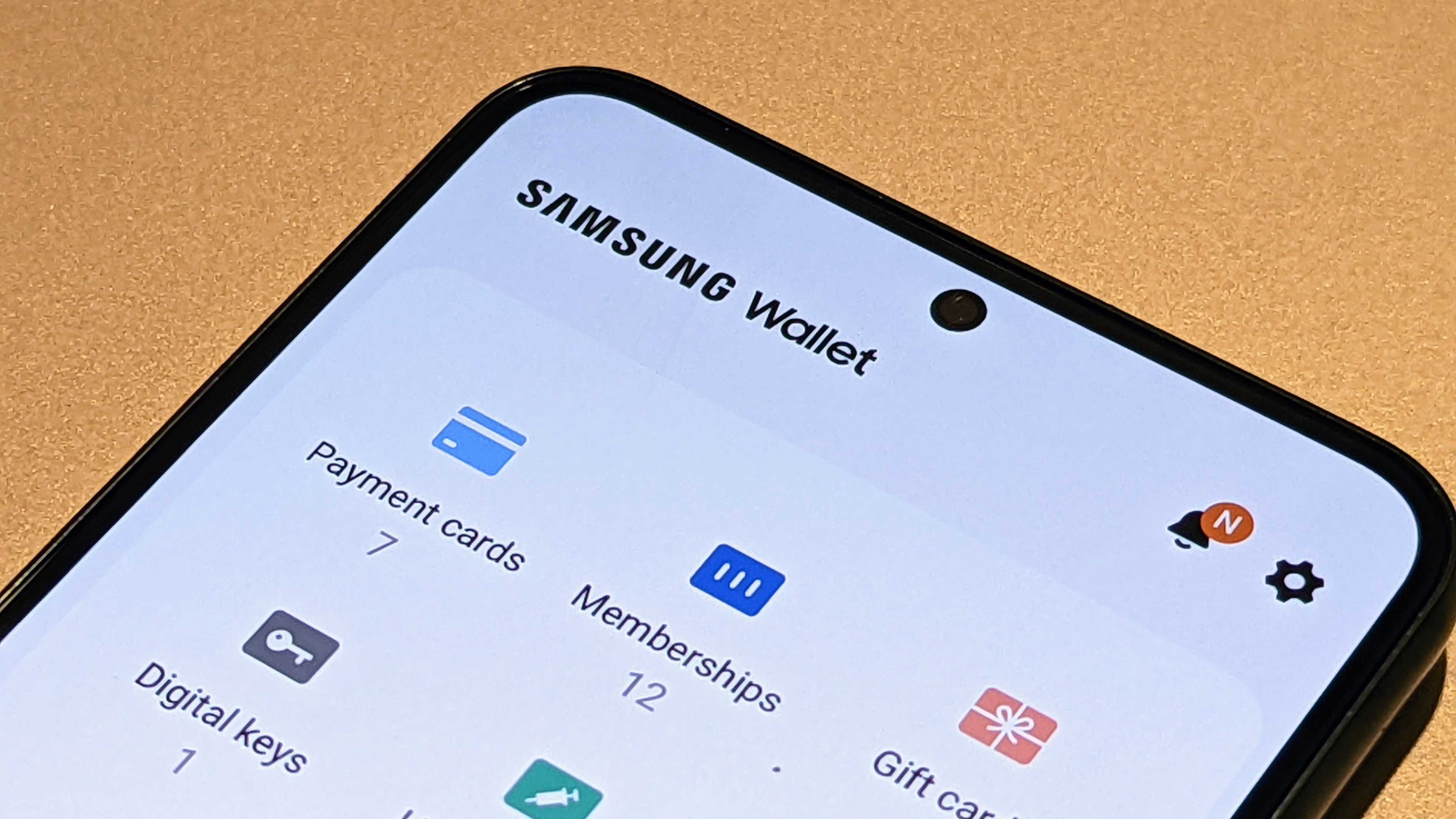Qualcomm Snapdragon 865: Top 4 best things (and 1 bad)
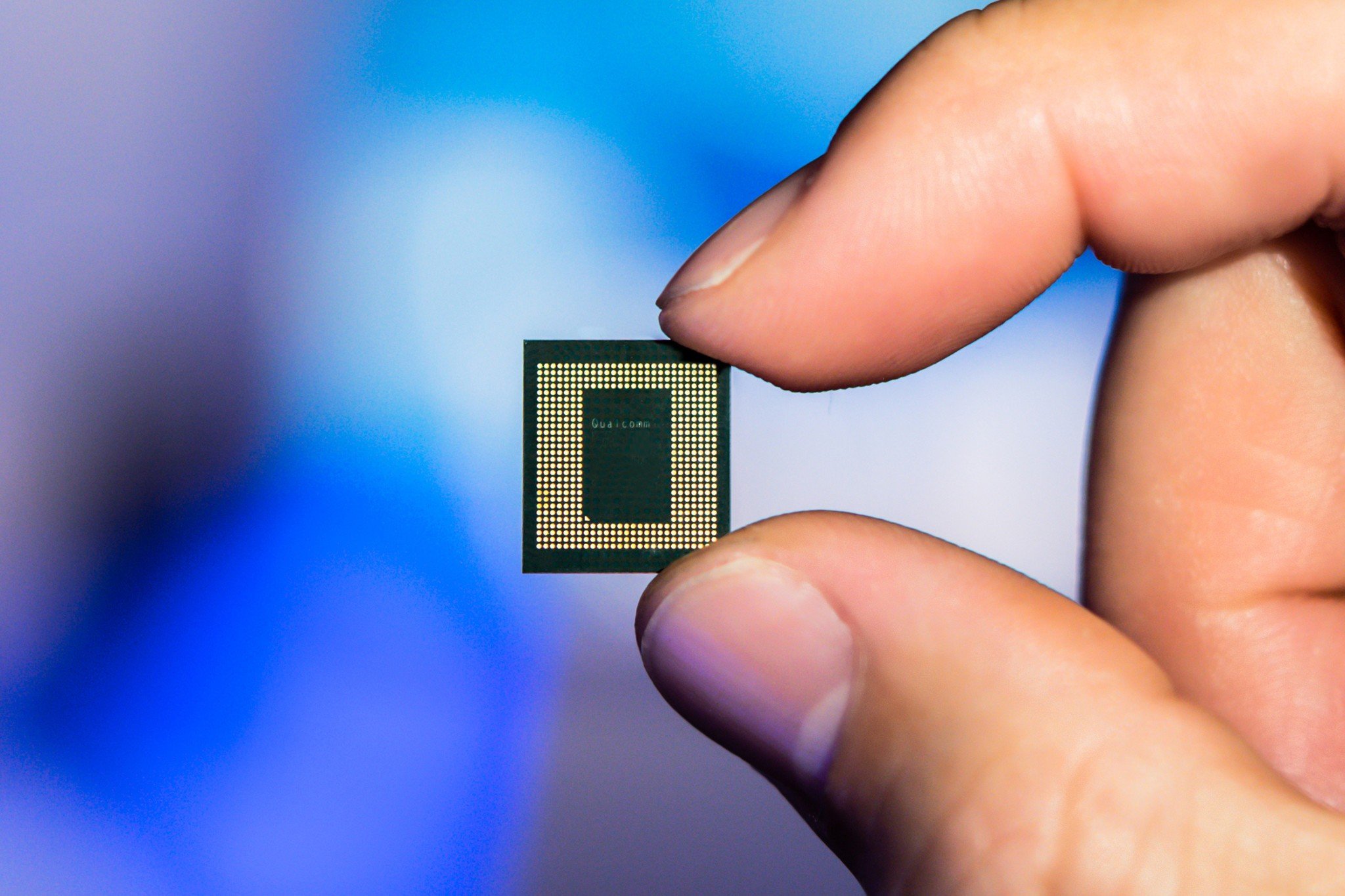
Like clockwork, Qualcomm is updating its flagship chip, the one that most high-end phones will use in 2020. It's called the Snapdragon 865, and it's got a lot going for it, including a renewed focus on graphical performance and an enormous boost in AI processing capabilities that could (should?) make it much easier for developers to tap into applications that rely on machine learning and neural networks.
Aside from the big-ticket items, there are a bunch of smaller features that you should know about the Snapdragon 865 — and some decisions that may leave you scratching your head.
But first, a disclaimer
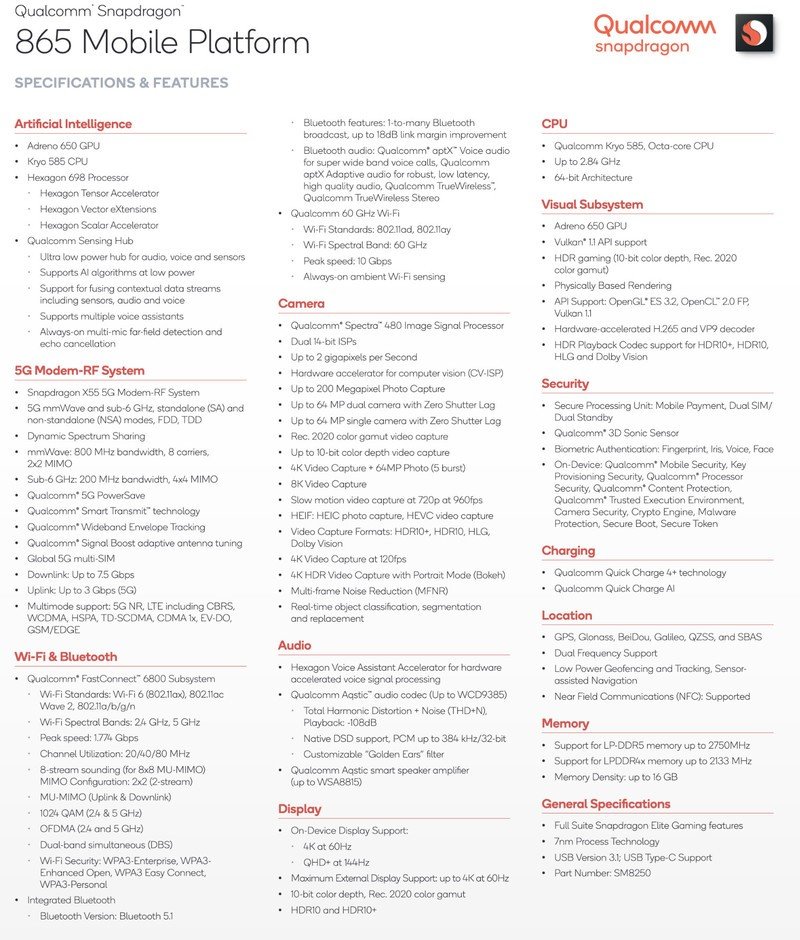
Here's the thing about the launch of a new SoC: it's a bunch of numbers, many meaningful and a few less so, but it's still all theoretical until the chip is integrated into the product. For example, last year Qualcomm touted its new ultrasonic fingerprint sensor technology, saying that it was undoubtedly a better, more secure option for under-screen biometrics. Turns out that only one manufacturer, Samsung, thought so, and that decision has plagued them throughout 2019, with poor accuracy and performance and a major security scare that forced Samsung to release a zero-day patch to all of its S10 and Note 10 devices.
So when we say that the Snapdragon 865 theoretically supports 8K video capture, that doesn't guarantee something like the Galaxy S11 or the Pixel 5 (hah!) will actually include that feature — other aspects of the phone, like the memory bus, will need to have corresponding bandwidth that Qualcomm can't control. Think of the Snapdragon 865 and other flagship SoCs as blueprints from which the phone manufacturers build their houses. The end results rarely look the same upon completion.
The Snapdragon 865 is all about gaming
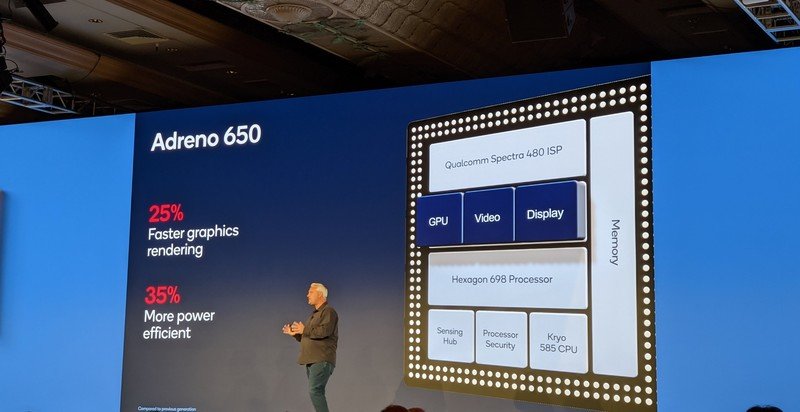
We'll start with something particularly meaningful: gaming. While not everyone who uses a high-end phone is a gamer, it's increasingly clear with games like PUBG Mobile, Fortnite, and Call of Duty Mobile that phones are a new vector for competitive gameplay, and as a result, companies like Qualcomm have to cater those audiences. We're already seeing "G" series variants of Qualcomm's mid-range chips — the new Snapdragon 765, for instance, has a separate "gaming" variant with a boosted GPU — but the Snapdragon 865 incorporates a bunch of new things.
As part of Qualcomm's Snapdragon Elite Gaming concept, the 865 pushes for more "desktop-like" rendering, focusing on dynamic lighting, which hasn't really been an emphasis in current mobile titles. We're not quite talking ray tracing here, but it's a start.
Another very cool aspect of the new Adreno 650 GPU is something called Adreno Updateable GPU Drivers, which has been a constant in the PC gaming world for years, but this will allow Qualcomm to work with specific game developers to update the Adreno GPU for that game without having to wait on Google's monthly security patches or major platform updates. You'll be able to download drivers using the Google Play Store, which could mean regular patches that improve game performance or fix endemic bugs. Big win!
Be an expert in 5 minutes
Get the latest news from Android Central, your trusted companion in the world of Android
Then there's the sustained performance. Games use a lot of GPU power, and as the chip starts to work, it also starts to heat up. As a response, the GPU clock speeds ramp down so prevent overheating, but that also impacts performance. Qualcomm says that the Adreno 650 is much better at actually sustaining performance for the entire length of a gaming session, both because the GPU is more efficient but also by ramping down other aspects of the chip to focus entirely on what's happening on the screen.
This is the first mobile chip to support updateable graphics drivers, which could be a boon to AAA titles specifically tuned for Snapdragon chips.
Finally, on the gaming side, the Adreno 650 will officially support 144Hz displays, a rumored feature of the Galaxy S11. While we've seen support for 90Hz and even 120Hz displays in the past year, official support for High Refresh Rate allows Qualcomm to, once again, work with game developers to ensure that the games don't only work great when they're reaching 120+ fps, but they also look great while doing it.
Of course, much of these advancements depends on game developers coming to the table and delivering on these consumer needs — it takes a lot of additional work to add desktop-level lighting and support for high refresh rate — but given that most of the world's flagship phones run Qualcomm chips, the big studios will likely have no choice.
Look out for 8K, and say goodbye to your phone's storage
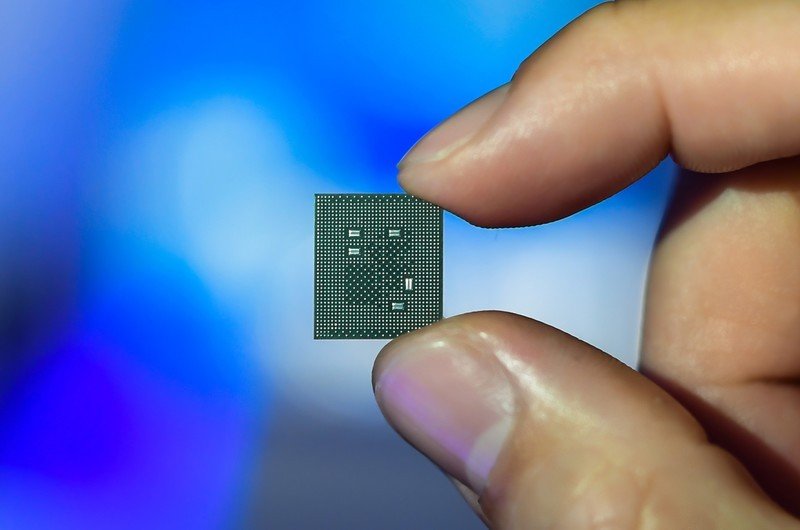
4K isn't even available on every phone yet (and definitely not 4K60) but Qualcomm is touting the ability for the Snapdragon 865 to support 8K video capture at 30fps. That's four times the numbers of pixels as 4K, which means a lot more storage and a considerable amount more memory bandwidth needed to keep ensure smooth capture. We're not even at the stage yet where every phone can capture 4K30 without dropping frames (ahem, Pixel 4), so I'm not entirely confident 8K will be fit for consumption when it's theoretically available, but it's a nice-to-have nonetheless.
Potentially more interesting on the imaging side, thanks to Spectra 480 image signal processor, is 4K video capture at 120fps, along with unlimited 960 frame-per-second slow motion, which would be a huge step up from the sub-second 960fps phones today can capture. Again, it'll be memory bus constrained, but it'll be supported on the chip side. Also cool: the ability to capture high-resolution photos while shooting 4K video, something that's heretofore not been possible.

Qualcomm's touting a ridiculous 200-megapixel photo limit, which would have sounded unreachable at the beginning of 2019, but we're now seeing devices shipping with 108MP sensors, so anything's seemingly possible at this point.
One of the more fascinating aspects of the new ISP is the work Qualcomm did with Dolby to offer direct-to-consumer Dolby Vision HDR capture. While Dolby Vision is increasingly touted as the HDR standard to beat in commercial productions, users will now be able to share that content directly to compatible TVs and monitors, like they could HDR10 earlier this year on the S855.
Finally — and this could be one of those subtle-but-important upgrades — is the new ISP's ability to perform image smoothing and denoising without ruining the detail of a photo. For smaller manufacturers like OnePlus and Xiaomi that don't want to build their own image pipeline, this could be the bridge they need to capture Pixel-quality photos in any lighting condition.
5G is included, whether you like it or not
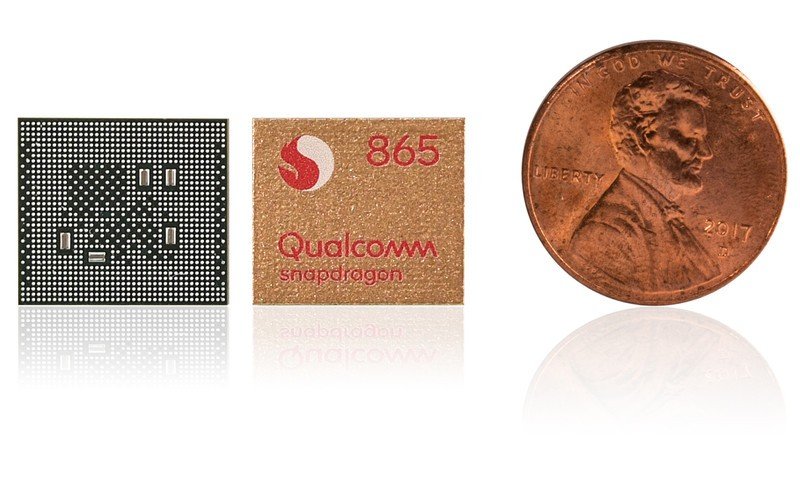
While the Snapdragon 865 doesn't have on-die 5G — which means it's not directly integrated on the primary chip itself — an X55 5G modem solution will be included on every version of the chip, whether the phone will use it or not.
In other words, every Snapdragon 865 will be 5G-enabled, but in countries where there are no supported networks, that part of the modem will be disabled, reverting to LTE.
To combat accusations that because it's not on-die, the X55 will make the Snapdragon 865 less efficient than an equivalent device with just LTE on-board, the company says that efficiency improvements made to other aspects of the chip, from faster TTS (time-to-sleep), lower-power envelope tracking and antenna power usage, will make up the difference. As a result, phones running the Snapdragon 865 should have the same or better battery life than those using its LTE-focused predecessor.
You're getting 5G on this chip whether you're in a market that supports it.
Given that 2020 is going to be the year of 5G, the X55 (which was announced back in February) will support a bunch of standards that should make its interoperability with LTE more seamless. In particular, Qualcomm is touting DSS, or dynamic spectrum sharing, as one of the ways 4G and 5G networks with co-exist nicely, as carriers can reuse the same spectrum for each standard and switch between them when the circumstances are ideal for 5G, falling back to the more mature LTE when necessary.
Also embracing the future of phone calls, most of which will happen over Bluetooth, Qualcomm is introducing aptX Voice, a "super-wide-band" Bluetooth codec meant specifically for voice calls made over wireless headphones. Given that most Bluetooth headphones are trash for phone calls, this is a welcome bit of news.
AI performance is TOPS-notch
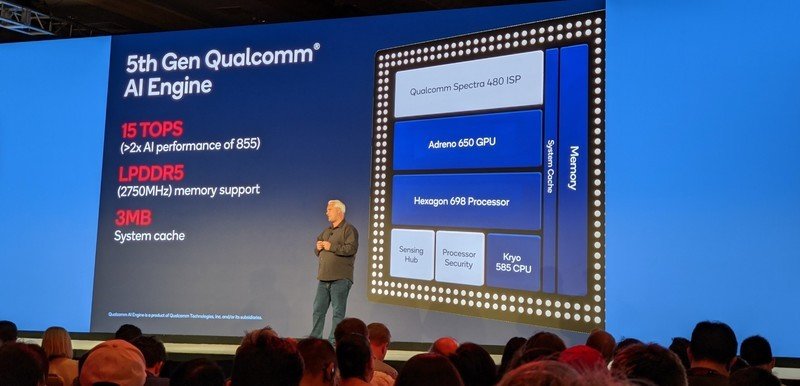
No one really understands how dedicated AI processors work, they just know that they make machine learning- and neural network-centered applications function properly.
Well, the Snapdragon 865 has an AI engine twice as powerful as the Snapdragon 855, for what it's worth. How that translates into real-world performance is real-world translation — at least that's how Qualcomm is pitching it. The Hexagon DSP can take in natural language in one language and spit out another in real-time, something that Google Translate has been touting for years, but the Snapdragon claims it can do it locally, on-device, as long as the language database is present.
The numbers are pretty astounding, too: 15 TOPS, or trillions of operations per second, which is an astounding figure. More important is that the AI engine has 3MB of dedicated L3 cache so it doesn't need to rely on the cache from the main CPU.
Perhaps more interesting is that the Snapdragon 865 has an always-on Sensing Hub, which means it can always be listening for hot words to multiple voice assistants — Google Assistant and Alexa, for instance — without impacting battery life.
The Kryo CPU portion hasn't changed much
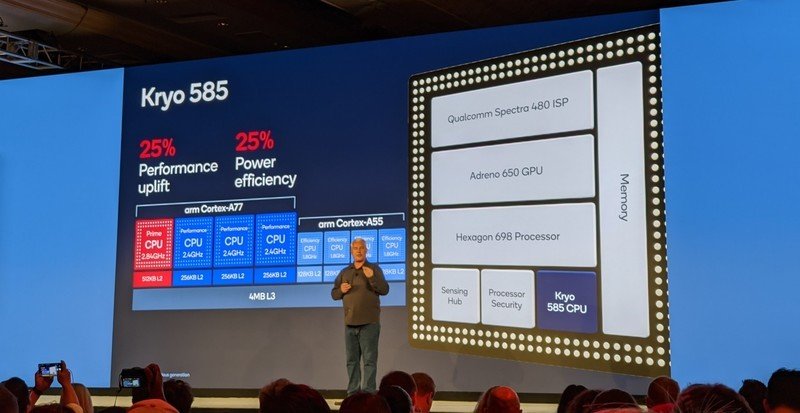
While we haven't had a chance to benchmark the Snapdragon 865 just yet, we're expecting modest gains in both single-core and multi-core performance from the Kryo 585 cores. Qualcomm claims the cores can perform up to 25% better in certain scenarios than the Kryo 485 cores in the S855, but it's still unclear whether that will translate to real-world performance gains.
The chip is still built on a 7nm TSMC process, and it uses the same configuration of four medium-performance cores, three high-performance cores, and a Prime core with a maximum burst speed of 2.84Ghz. The four faster cores have been upgraded to ARM's new Cortex-A77 configuration, though, which is more efficient per clock, while the low-power cores are now based on Cortex-A55.
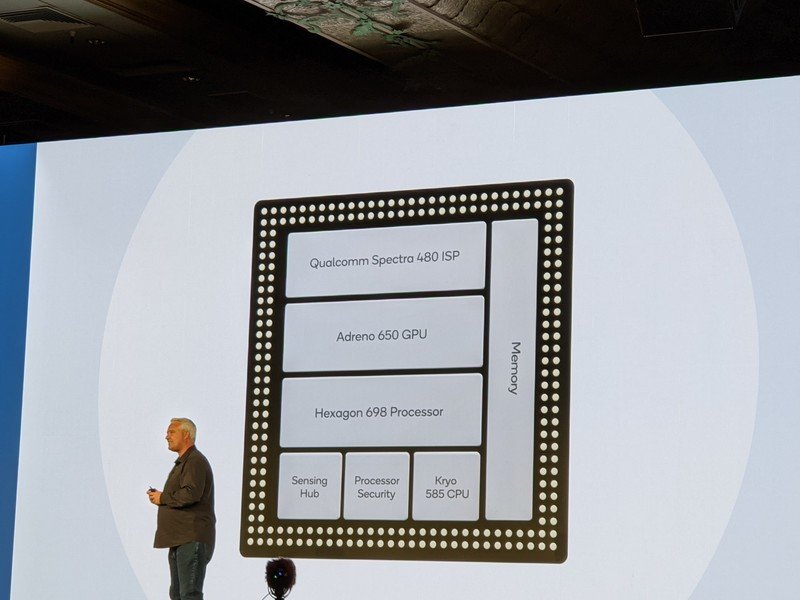
In other words, this is going to be an impressive chip but don't expect it to catch up to the Apple A13 (or even the A12) in terms of single- or multi-core performance, but the chip is 35% more efficient which will inevitably translate to better battery life.
It's good, but what choice do you have anyway?
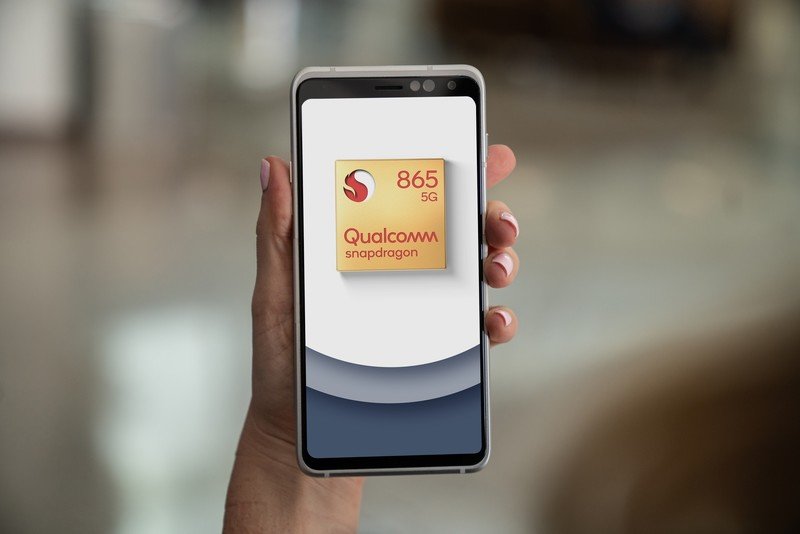
Qualcomm is everywhere. There are a lot of substantive improvements to this year's flagship SoC, but at the end of the day, it wouldn't really matter if the company decided to make tiny, insignificant improvements instead. Qualcomm products are ubiquitous around the world, and power basically every phone released in North America that doesn't come from Apple.
At the same time, Qualcomm's under considerable pressure to match the speed of innovation set by Apple's A-series chips in recent years, and must maintain their lead against HiSilicon (and to a lesser extent, the diminishing Exynos, and while it's failed to compete on a pound-for-pound compute level, Qualcomm continues to outpace every other chipmaker in the breadth of its feature set.
Of course, this year is all about 5G, and there's no lack of consternation around the fact that the Snapdragon 865, unlike its cheaper Snapdragon 765 counterpart, doesn't have it integrated. That doesn't mean it's not essential to the success of the chip, just that we haven't quite reached the point of maturity for the new standard that Qualcomm and most U.S. carriers would like us to think.
Qualcomm Snapdragon 765: What it is, and why it matters for 5G phones in 2020
FTC Disclaimer: Qualcomm sponsored Android Central's travel and accommodation for the Snapdragon Summit. They did not have editorial oversight over any of this content.
Daniel Bader was a former Android Central Editor-in-Chief and Executive Editor for iMore and Windows Central.

